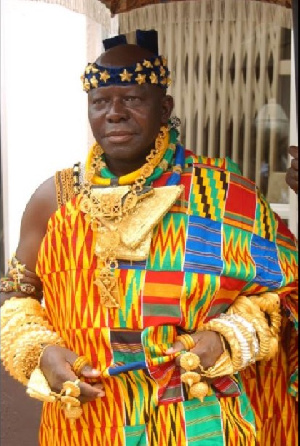The Asanteman Council is the highest traditional authority in Asante and has been in existence for over three hundred years since the foundation of the Asante Kingdom (Asanteman) by Opemsuo Osei Tutu I, Asantehene, and his Priest Counsellor, Okomfo Anokye.
Its membership comprises the Asantehene, Asantehemaa and the heads of the traditional areas, Amanhene (formerly designated Native States) within Asanteman.
The Asanteman Council does not derive its existence, functions or authority from any Statute Law.
In 1932, Mr H.S. Newlands, the Chief Commissioner of Ashanti, advised His Majesty’s Government (of Great Britain) “to no longer continue to disregard the desire for unity manifest among the Ashantis, and perpetuate the state of disruption of Ashanti native institutions which it had forced on Ashanti in an unsuccessful attempt to disunite its peoples”.
This advice was heeded and the Ashanti Confederacy, together with the position of Asantehene as its head, both of which had been in suspension since Otumfuo Agyeman Prempeh I was exiled to the Seychelles Island in 1896, was restored on January 31, 1935.
In his speech on that occasion, the Governor Sir Arnold Hudson observed: “Henceforth, the ancient loyalties of the Ashanti divisions are to be officially recognised and sanctioned; every man in these divisions will enjoy his rights and render due service under the form of government familiar to his ancestors, all will pay homage to the Asantehene and venerate the Golden Stool, that symbol of unity among you for many generations.”
He emphasised: “In this restoration, there is no new creation but a return to former institutions”.
In a celebrated judgement by Mr Justice K Ampiah at the High Court, Accra, in 1984, the position of the Asanteman Council was clarified as follows:
“This body has been referred to through the ages by different appellations, namely as “Asantemannhyiam”; “Asante Kotoko”; “Asante Confederacy”; “Asante Confederacy Council”; “Asanteman Council” and simply as “Asanteman”.
This body consists of all the chiefs and persons holding chiefly positions in Asante.
It is in fact a meeting of all the Asante Nation; it is the “United Nations” of the Asante Nation.
It is the bond of unity among the Asante with the Asantehene, the occupant of the Golden Stool to whom all the chiefs owe allegiance, at the apex.
The spirit that binds them together is the “Great Oath” (Ntamkessie).
This body, at various stages in history, has exercised legislative, executive and judicial functions.
I find that when the whole of Asante meets, such as the one held on April 26, 84, it is no other than the meeting 12 of the “Asanteman” which for better form of description is invariably referred to as the Asanteman “Council”; the “Council” replacing the vernacular expression of “Nhyiam”.
Is this body a customary creation or a statutory one?
It is known that before the Restoration of the Ashanti Confederacy in 1935 or thereabouts, there existed this united body of the Asante chiefs.
Among other things the government recognised the existence of this Asante Assembly of Chiefs with the Kumasihene, now recognised as the Asantehene, as its head.
It recognised the functions of this body and restored to it its customary rights.
It is, therefore, patently clear that before the government took full recognition of the Asante Confederacy, and started making statutory provisions to govern it, there existed already a customarily united body in the Asante Nation.
As I have already said, this body became known by various names – namely “Asanteman”, “Asanteman Nhyiam” and the “Asanteman Council” as it is now popularly referred to.
I hold, therefore, that the Asanteman Council is a customary creation and not a statutory one.
No mystery, therefore, needs to surround the Asanteman Council nor is it a “new wrinkle into the folds”.
It is a traditional council which was established about three hundred years ago and owes its functions and authority to Asante customary law and usage.
It is, therefore, an institution which is recognised under, and protected by, Art 270 (1) of the 1992 Constitution of Ghana.
“The Institution of Chieftaincy, together with its traditional councils as established by customary law and usage is hereby guaranteed”.
The writer is the Private Secretary to Otumfuo Osei Tutu II, Asantehene

